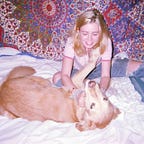Revealing Revelers and the Carnival Costume Conflict
All weekend before the West Indian Day Parade in Brooklyn, soon-to-be revelers were heading out to pick up their costumes in the heavy rain. At Freaks Mas, a store for all-things-Carnival in East Flatbush, there was a long white table covered with bright plastic jewels, sequins and feathers that nicely countered the gloomy weather. “Don’t worry she’s coming back in to pick it up once we glue this back on and fix the bra!” someone shouts across the room. Besides the table, the room is surprisingly bare, with one or two mannequins wearing bright pink bikinis dripping with beads hanging on the white wall.
The crucial ingredient to ‘playing mas’ is the costume. A sense of ritual defines choosing a costume and its design. The managers of bands begin planning costume themes anywhere from six months to a year before the parade, and they work until the last possible moment to make the costumes perfect. Many women at the parade had ordered their costumes at least three months in advance.
There is a duality in the costumes that seeks an over-the-top opulence, with as many elaborate accessories as possible, combined with a kind of minimalism that allows the uncovered body to be the key piece of the outfit. A tension, however, arises among women around whether the costumes symbolize a cultural freedom or are a good reason to wear a fun and sexy outfit in the streets.
At the Carnival Parade on Labor Day, people play “pretty” mas. This is a type of masquerading that has turned them away from more traditional costumes, to an emphasis on revealing visual aesthetic. Depending on the price of the costume, the number of pieces will vary.
Takia Royal, a young woman working at the steel drums festival, showed a photograph of the costume she would be picking up the next day, “I wanted that frontline look, so I was willing to pay a bit more for this one”. It was a two-piece set in black leather with bright blue and purple beading creating feather shapes with an elaborate headpiece the curled down onto her forehead. The blue, green and purple feathers on her back dramatically framed the upper half of her body.
Althia (Tia) McKenna, the manager of Freaks Mas, sat in her backroom office. She described the different possibilities for costumes while every so often answering a call from a frantic costumer. Backline is just panties and a bra. A midline look adds perhaps a collar and a headpiece. Frontline means a lot of feathers on the back, arms and maybe legs. Freaks Mas also offers an ‘ultra-frontline’ look, which is “very extravagant”. Having the ultra-frontline look could cost up to $1,300.
“Our girls like being fancy, they like the glitz, and the glam” said McKenna. “Older bands, they don’t like the nakedness.”.
“Carnival is a sanctioned moment of freedom…where the meek become the most powerful”, said Kaiama Glover, associate professor of French and Africana studies at Barnard College. Carnival is the one day you can “let it all hang out, let your hair down”. Ms. Glover then posed the question, “but is appearing sexy empowering? Or mainly demeaning?… You don’t get to control how you’re read and how you’re touched, metaphorically and literally.”
“Rihanna recently broke the internet with her carnival costume — very clearly saying ‘I am a sexual being. That’s how I brand myself, that’s my power’ but remember, she is surrounded by an entourage, if someone touches her in the way she doesn’t like… Rihanna can walk down any street in the nude and she’s pretty much safe”.
“Sometimes guys are abrasive”, said Royal, “but you know how to handle yourself”.
Donna Dove is a fashion designer and artist born in Trinidad, based in Harlem. She designed the costumes for ‘Kritical Mas’ this year because “we live in critical times”. Ms. Dove’s designs were seen at J’ouvert, a more overtly political parade in the early morning of Carnival. Her costumes are long pieces in white because “white symbolizes peace”. She explains that her group is a “mature” crowd — most women in it are older than thirty, (and a even few almost in their eighties). “We don’t do G-strings — we want to make a statement, not just dance”. Ms. Dove said that she’s “cool with it, that young people want to show off their bodies”, but those kinds of costumes have “no [cultural] basis, and no imagination behind them.”
Loretta Green, a woman from Jamaica who came to the U.S. in the 60s, was helping models for ‘Fashion in Mas’ prepare for the parade. Green rejects the seemingly dichotomist nature of the costume argument. “You have a white Protestant view of the body.” She explained. “When we whine the line, it is part of the culture. There are no sexual connotations. We have a different relationship to the body than in America, because America destroys and sexualizes the image of the female body”. Green said that Caribbean culture is often eroticized by Americans and the perception of the parade, therefore, as something sexual or not is a poor way to frame it.
During the parade, the atmosphere was not crass. It was loud, it had Caribbean pride, and most importantly, it was fun. The observers of the parade were not ogling the revelers, but dancing along on the sidelines.
